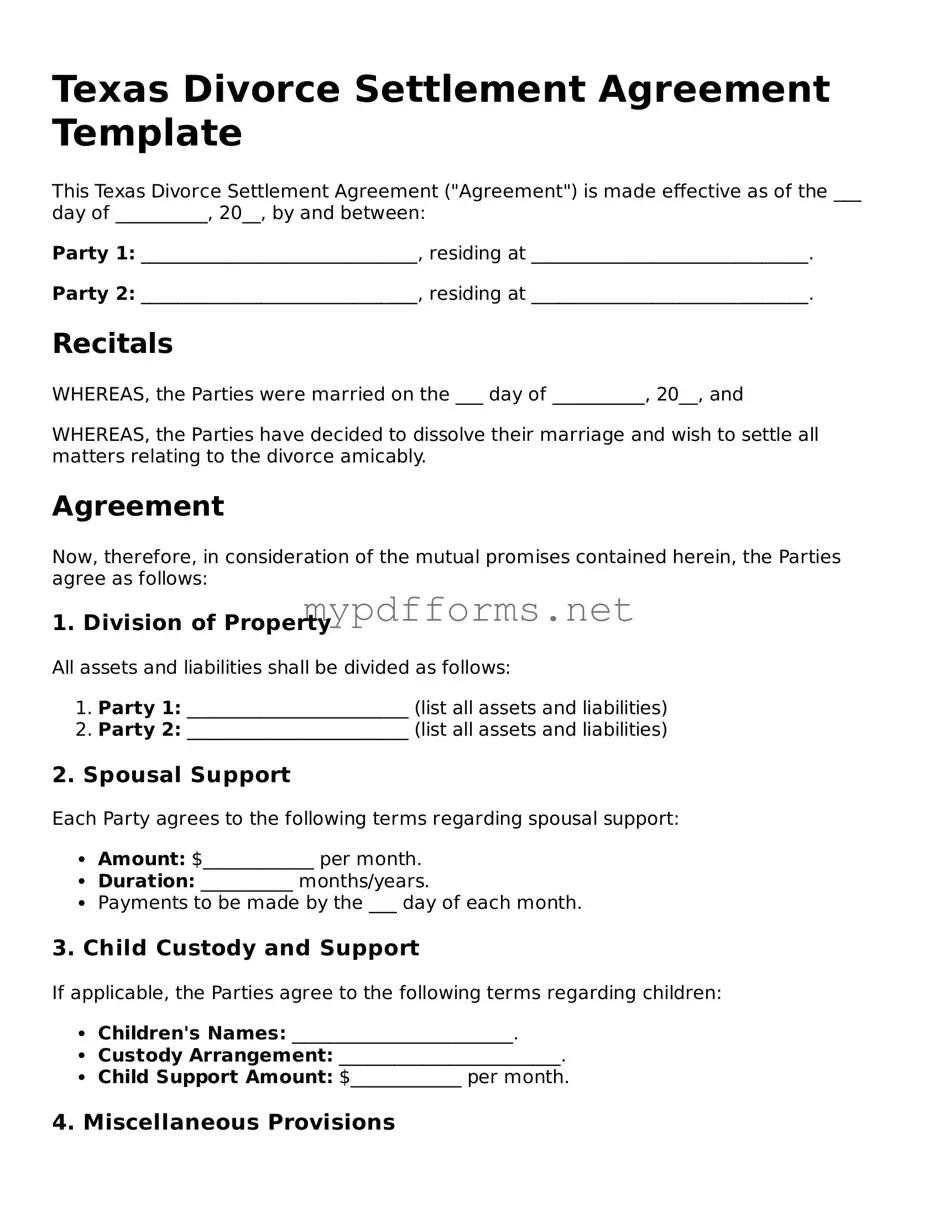The Texas Divorce Settlement Agreement form shares similarities with the Marital Settlement Agreement. Both documents aim to outline the terms of a divorce, including asset division, child custody, and support arrangements. A Marital Settlement Agreement is often used in uncontested divorces, where both parties agree on the terms without the need for court intervention. This document serves as a binding contract that details each party's responsibilities and rights following the dissolution of the marriage.
Another related document is the Separation Agreement. This is typically used when a couple decides to live apart before finalizing their divorce. Like the Divorce Settlement Agreement, a Separation Agreement addresses issues such as property division, child support, and custody arrangements. It allows couples to establish terms while still married, providing clarity and reducing conflict during the separation period.
The Child Custody Agreement is also similar, focusing specifically on the arrangements for children involved in a divorce. This document outlines custody arrangements, visitation schedules, and child support obligations. While the Divorce Settlement Agreement covers a broader range of issues, the Child Custody Agreement is crucial for ensuring that children's best interests are prioritized and clearly defined.
The Property Settlement Agreement is another document that parallels the Divorce Settlement Agreement. This form specifically deals with the division of marital assets and debts. It ensures that both parties understand how property will be allocated, which can help prevent disputes later. While the Divorce Settlement Agreement encompasses various aspects of the divorce, the Property Settlement Agreement hones in on financial matters.
A Parenting Plan is similar in that it outlines the arrangements for raising children post-divorce. This document specifies parenting time, decision-making authority, and communication methods between parents. While the Child Custody Agreement focuses on legal custody, the Parenting Plan provides a more detailed framework for day-to-day parenting responsibilities, ensuring a smoother transition for children.
The Alimony Agreement is another related document that addresses spousal support. This agreement details the amount and duration of financial support one spouse will provide to the other after separation. While the Divorce Settlement Agreement may include provisions for alimony, a separate Alimony Agreement can offer more specificity and clarity regarding the terms of support.
The Quitclaim Deed is similar in that it relates to the transfer of property ownership. In the context of a divorce, a Quitclaim Deed can be used to transfer property from one spouse to another as part of the settlement. This document ensures that ownership rights are clearly defined and legally recognized, which can be crucial for both parties moving forward.
When dealing with vehicle transactions in Maryland, understanding the essential Motor Vehicle Bill of Sale requirements is crucial. This document serves as a legally binding record of the sale and is vital for both the seller and the buyer. Ensure you have all necessary details correctly represented by utilizing the proper form available online. For more information, check out this resource: essential Motor Vehicle Bill of Sale document guide.
The Final Judgment of Divorce is another document that serves as a conclusion to the divorce process. This legal document finalizes the divorce and incorporates the terms outlined in the Divorce Settlement Agreement. It is essential because it makes the agreement enforceable by law, ensuring that both parties adhere to the terms established during the divorce proceedings.
Lastly, the Financial Affidavit is similar in that it provides a comprehensive overview of each party's financial situation. This document is often required during divorce proceedings to ensure transparency regarding income, assets, and debts. While it does not directly outline the terms of the divorce, it plays a crucial role in informing the Divorce Settlement Agreement by providing the necessary financial context for negotiations.
